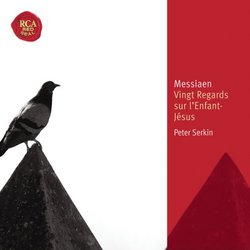Still Unsurpassed Profundity!
Scriabinmahler | UK | 11/30/2007
(5 out of 5 stars)
"
Peter Serkin's very profound and mystic account of Vingt regards still remains as a touchstone for other pianists. Nowadays Osbourne, Austbo and Aimard play the pieces beautifully but their cool and impressionistic interpretation lacks depth and spiritual element so essential to Messiaen's music. Serkin's pianism has everything, solid technics, huge bravura, subtlest touch, shimmering tonal colours, and spiritual depth. It's just amazing piano can express so much and so richly. Recorded beautifully in 1974, remastered sound has very realistic presence.
For more virtuosic interpretation, check out Beroff's very thrilling and sensitive EMI recording, also bargain price!"
Still the best
P. Kelley | SC United States | 11/20/2006
(5 out of 5 stars)
"Peter Serkin is both the pioneer and definitive performer of this work. His attention to the composer's tempo, dynamic, and rythmic markings are impeccable, though never slavish. He never tries to smooth over dissonances, though he also never exploits them for effect. Serkin also manages to bring out the recurring harmonic and thematic elements (peculiarly called "repetitiousness" by the reviewer) essential to understanding the architecture of the piece. This is especially apparent in his "Regard du fils sur le fils" in which the various dissonant chords in the extreme treble never detract from the "theme of love" in the left hand. His "Baiser de l'enfant Jesus" is incredible, especially the close with its sublime arpeggios. In Serkin's performance, one immediately detects the influence of Liszt ("Benediction de Dieu dans la solitude") on Messiaen, as well as Debussy in the wonderfully static "Je dors, mais mon coeur veille." Serkin's recording techniques for this piece were also quite innovative and give the work a strange out-of-this-world feel that doesn't exist in more recent recordings (Beroff): I own the original vinyl and couldn't believe my ears on relistening. Check out especially the descending figure in the treble in "Premiere communion de la Vierge": the notes sound as if they were beamed in from outer space!"
A devotee's early--and very fine--performance of Vingt Regar
Santa Fe Listener | Santa Fe, NM USA | 06/14/2006
(5 out of 5 stars)
"The Amazon reviewer is right that these "Twenty Views" of the Christ Child are not made more understandable by their Biblical subtitles, or for that matter their main title, either. One senses ntothing especially religious, devotional, mystical, or child-like in Messiaen's various episodes. The idiom is nowhere near as fierce as the Amazon reviewer warns, however. There is little obsessive repetition, and the music is actually more often soft than loud. It's colofrful to say that the piano is made to "sing, speak, growl, clang, crash, and scream," but many of the episodes are gently reflective.
Messiaen has invented a variation on Debussy's discovery that the piano can be released from formal structure into free expression, color painting, and mysteriously shifting moods. However, Debussy employed a much wider harmonic range. Messiaen has some favorite chords and exotic effects, including his famous birdcals, that are displayed across a wide range of rhythms and fragmented phrases.
You'd never expect that such a long, rather opaque work could become a hit with audiences, but it has. I msut admit that Messiaen's idiom becomes hypnotic, and the simple forms, plus the absence of much dissonance, makes it easy for listeners to sink into the music.
Peter Serkin was a pioneer in the Vingt Regards, and although later recordings have shown wider dynamic ranges and fiercer attack, his inward way seems perfect--this CD is a classic of modern music performance."

